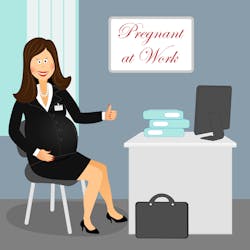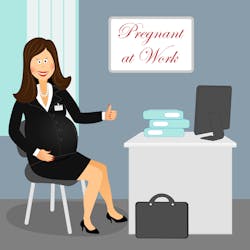Treading softly around maternity leave
Attention dental office managers: LOAs must be handled as gently as a newborn baby.
Nearly all doctors and their office managers eventually have an employee who is pregnant and needs to take a maternity leave of absence (LOA). Scheduling this leave can prompt special concern at busy, small- to medium-sized practices, where staffing is like assembling a jigsaw puzzle while juggling. How much time should be allowed? Is this paid or unpaid leave? What if an employee is unclear about returning to work? What if, heaven forbid, a pregnant employee is also one of your problem employees?
As with any topic involving the risk of discrimination claims, maternity leave must be handled as carefully as a newborn baby. Pregnancy discrimination is a top area of EEOC enforcement, and the employee almost always wins. Legally speaking, when an employee asks for maternity leave, management must keep the following in mind:
1. You CANNOT ask a pregnant employee for a doctor’s note certifying that it’s OK for her to continue working.
2. You CAN require certification of the need for leave.
3. You CAN require certification that the employee is OK to return to her duties after the LOA.
4. You should NEVER force a pregnant employee to take time off, nor assume she wants to reduce her hours, even if you have the best intentions. The choice must be hers.
5. Finally, NEVER assume that a pregnant employee intends to leave the practice, whether or not she’s requested time off.
What about the leave itself, though? What length of time is reasonable or required?
Federal law doesn’t require employers with 50 or fewer employees to specifically grant Maternity LOA, but almost every state requires that you treat pregnancy like any temporary medical disability, and some states have stricter rules. Many small practices allow six weeks, but it’s important to verify with an HR expert or employment law attorney that this is OK. Employers with 50+ employees must grant the full 12 weeks required by FMLA.
Whatever the length of the leave, your office manual must clearly describe your LOA policies. Include how employees should request leave, and indicate that it is their responsibility to let you know what date they plan to return. Address what happens if the employee fails to return when planned, and under what conditions an extension may be requested. Include what happens if the company downsizes, and discuss benefits and bonuses while the employee is on leave. Remember, this is not an exhaustive list of what your policy must include – you really do need to consult an expert.
What if an employee doesn’t specify her plans after the LOA?
Having the right policies in place means that both you and the employee are better supported in your interactions. It is now her responsibility to keep you informed of her plans, so if she didn’t provide all information you need, ask for it: “Sally, the other day you indicated that you wanted to take six weeks off during your pregnancy, but you didn’t mention your plans as far as coming back to work. What are your plans?”
In this way, you can verify that the pregnant employee is asking for accommodations within the scope of your policy, address the issue if not, and determine when she expects to return to work. Document your interactions, and make sure she knows she must keep you up to date if anything changes. In many circumstances, this is sufficient to ensure a smooth LOA and return.
What if a pregnant employee is a problem employee?
Every once in a while our CEDR advisors are contacted about problem involving a pregnant employee, after the employer has reached a “last straw” situation. What terrible timing! As an employer, having any solid ground in this scenario depends on already having the right policies in place and having flawless documentation of all employee issues and coaching to back you up. Even then, your “solid ground” is about two square inches and in the middle of a swamp.
Take the story of “Denise,” an employee with long-term attendance and attitude problems. Unfortunately, Denise was a tough cookie to confront, so no action was taken by management. Denise subsequently announced she was pregnant, and meanwhile, her attendance and attitude problems continued. After her LOA, management didn’t even want her to return to her full-time position – performance errors were discovered while she was gone, she never worked her schedule anyway, and her baby had health problems that seemed likely to make her chronic absenteeism even worse. The practice eventually decided to terminate and cite past (undocumented) performance issues. Only trouble is, the practice is now being sued, and will certainly lose.
Now, Denise was a terrible employee from six minutes after she was hired – but you can’t fire your “bad apple” employee now (rather than a long time ago, when you should have) merely because you think her pregnancy will cause more trouble, or because her LOA turns out to be a relief. Nor can you reduce her schedule unless you’re cutting hours all around. In fact, if you throw up any extra roadblocks to her returning to work, you might as well hire a lawyer for her, the EEOC case will be so easy to win.
You’re already past your (policy) due date
The only way for an employer to triumph in this situation is to avoid it completely. Get the right policies in place now – created by an expert who knows the pitfalls to avoid and protections to include. If your handbook was drafted by an enthusiastic amateur, get it checked (we even do it for free). Never neglect your documentation, take action when you need to rather than nine months too late, and make sure you’ve anticipated all risk factors before letting any employee go. And to round out your strategy, always seek expert HR advice before taking major action – because if you don’t tread softly around maternity LOAs, you’ll wake the EEOC.
-----------------------------------
Also by Paul Edwards: Terminations and layoffs: They're NOT tomatoes and tomahtoes | Are YOU a great boss?
-----------------------------------
About the Author
Paul Edwards is the CEO and Co-Founder of CEDR Solutions. Since 2006, CEDR has been the nation’s leading provider of individually customized dental office policy manuals and HR solutions, helping dentists successfully handle employee issues and safely navigate the complex and ever-changing employment law landscape. Have a tough termination looming on the horizon? If you’d like a little clarity or guidance, just give CEDR a call at 866-414-6056 or visit www.cedrsolutions.com. Our HR experts will help you solve one issue for free.

